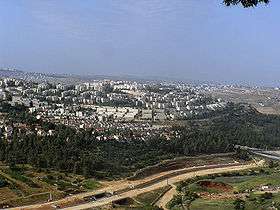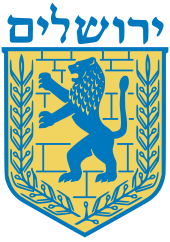Ring Neighborhoods, Jerusalem

The Ring Neighborhoods of Jerusalem (Hebrew: שכונות הטבעת) are eight suburban neighborhoods built as satellites to central Jerusalem. The first neighborhoods built after 1967 were Ramot, French Hill, Neve Yaakov, Pisgat Ze'ev, East Talpiot, and Gilo.[1] In the 1990s, Ramat Shlomo and Har Homa[2] were added to the list. The international community does not recognize Israeli sovereignty over East Jerusalem and considers the neighborhoods illegal settlements, but the Israeli government disputes this.[3]
History and legal status
In 1967, following the Six-Day War, the makeup of Jerusalem was altered. Plans were drawn up to establish new residential neighborhoods on undeveloped land around Jerusalem as a housing solution for young couples, new immigrants, and middle-class families seeking a better quality of life. The city's territory was increased to 108 km2 (42 sq mi) when Israel unilaterally annexed areas north, east and south of the city to Israel, totaling an area three times the size of pre-war West Jerusalem. Today, as many as 165,000 people reside in these communities. According to the United Nations and the European Union,[4] due to their having been built beyond the Green Line, the neighborhoods Israel subsequently built on these annexed grounds are considered to be Israeli settlements, leading them to be considered illegal under international law based on the Fourth Geneva Convention and United Nations Security Council Resolution 476.[5][6][7] Israel disputes this, maintaining that these neighborhoods are part of the municipality of Jerusalem, and therefore under Israel's sovereignty. The United States position has been inconsistent. The United States abstained from voting on Resolution 476 and the US Congress has declared that "Jerusalem should remain an undivided city... the capital of the State of Israel" in the Jerusalem Embassy Act.[8] On the other hand, the Obama administration has stated that East Jerusalem settlements must halt construction and expansion permanently.[9] Canada has also shown wavering stances regarding the neighborhoods,[10] by using ambiguous wording or refusing to outwardly classify the neighborhoods as illegal West Bank settlements.
Neighborhoods
- Ramot is located at north-west, north of Highway 1. Established in 1974, it has about 50,000 residents as of 2015.[11]
- Ramat Shlomo, due north of downtown was established in 1995. It has an almost entirely Haredi population of 20,000 as of 2014.[12]
- Neve Yaakov is the northernmost neighborhood in Jerusalem. Established in 1970, it has about 30,000 residents as of 2014.[13]
- Pisgat Ze'ev in the north is the largest neighborhood in Jerusalem. Established in 1982, it has about 50,000 residents.[14]
- French Hill in the north-east was established in 1968. It has a population of over 6,600 residents.
- East Talpiot (East of Talpiot) is located on the eastern edge of the city, situated near the Commissioner's Palace. Established in 1973, it has about 15,000 residents.
- Har Homa in the far south-east was established in 1997. It has about 20,000 residents.
- Gilo at the south-west of the city, is the highest neighborhood. Established in 1971, it has about 40,000 residents.
Another Jewish neighborhood in Jerusalem built over the Green Line, Ramat Eshkol (the first to be built), is not considered to be part of the Ring Neighborhoods.
References
- ↑ "Israel and Palestine" (155–162). 1990: xxxi.
- ↑ Zogby, Dr. James J. (16 November 2010). "Instructors the backbone of safety on our roads...". Gulf Daily News. Retrieved 21 March 2012.
- ↑ "The Geneva Convention". BBC News. 10 December 2009. Retrieved 27 November 2010.
- ↑ EU rebukes Israel for Jerusalem settlement expansion (EUObserver, November 19, 2009)
"The presidency recalls that settlement activities, house demolitions and evictions in East Jerusalem are illegal under international law." - ↑ Resolution 476
- ↑ SMH.com.au
- ↑ A Palestinian Academic Society for the Study of International Affairs study notes (citing from another analysis) that "'since 1967, two rings of new residential neighborhoods built around the city center have created new ramparts [emphasis original] designed primarily as a political barrier against any possible repatriation of the city.'" And concludes that: "the strategic placement of these four settlements formed the key links of the inner ring of settlements between East Jerusalem and the West Bank. Passia.org
- ↑ Jewishvirtuallibrary.org
- ↑ Analysis: Obama's press on Gilo shows a continued misread of Israel (Jerusalem Post, February 8, 2010)
- ↑ Thestar.com
- ↑ Residents, JNF Oppose Housing Plan for Environmentally Important Jerusalem Site
- ↑ Terror Attack in Jerusalem’s Ramat Shlomo Neighborhood
- ↑ Jerusalem’s Neve Yaakov: 90-Year-Old ‘Settlement’
- ↑ Pisgat Zeev Neighborhood
